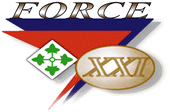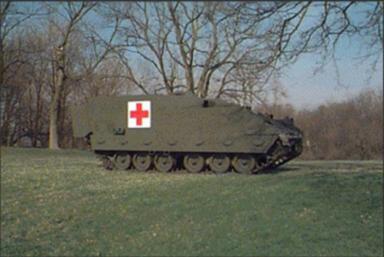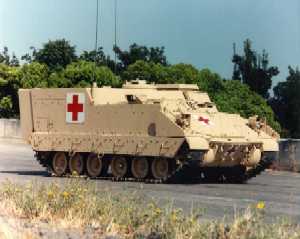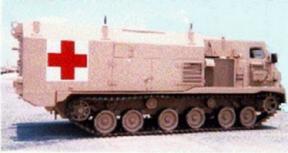![]() 1st Battalion 22nd Infantry
1st Battalion 22nd Infantry ![]()
1-22 Inf tests medical vehicle

By Spc. Jacqueline Griggs
28th PAD, Fort Irwin, Calif. July 3, 1997
The heat, dust, and harsh training of the
Advanced Warfighting Experiment battlefield at the National
Training Center causes serious medical problems
or casualties for many soldiers participating, but combat medical
specialists are evacuating and treating the soldiers quickly and
proficiently
with the Armored Treatment Transport Vehicle, a Force XXI
initiative here.

An early model ATTV
Soldiers of Company B, 4th Forward Support
Battalion, 4th Infantry Division, Fort Hood, Texas, and the
Combat Support Command,
working with Task Force 1st Battalion, 22nd Infantry
(Mechanized), are impressed with their testing of the
ATTV.
I'm hoping the Army keeps the system and adopts
it very soon," said Spc. Melancthon S. Spencer, combat
medical specialist, Co. B, 4th FSB.
"The diversity of the vehicle and the training is
great."
The ATTV, based on an MLRS chassis, replaces the evacuation of casualties by a Humvee or an M-113 transport tank.
According to the medical soldiers, the ATTV
attributes various functions that provide proper treatment of
casualties during the two-week battle
including spacious room for patients, higher speed for drivers,
and more lights for medics.
"The speed of it impresses me the most," Spencer said. "The ATTV has a top speed of 45 miles per hour and before, the M-113 ran 30-to-35 mph."
The larger size of the transport vehicle allows
the room to move and treat the patients while the vehicle is
rolling.
More room in the ATTV also permits the installation of a large
three-door medical chest replacing several small medical kits.

In its earliest form the ATTV
was renamed the M2A0 AMEV
(Armored Medical Evacuation Vehicle)
The soldiers will be happy to hear about the safer protection the ATTV provides for the casualties during the battle, according to Hecht.
"The six litters are padded nicely and the
bolts of the litters are more secure, but easier to detach if
needed," Hecht said.
"The generator has the power to provide heat or air
conditioning for heat casualties or cold-weather casualties
and provides more types of lights to work with like regular
lights and some fluorescent lighting."
It also provides protection in an nuclear, biological, chemical environment.
"The ATTV contains a four percent NBC
overpressure," Spencer said.
"This means the treated soldiers inside the ATTV won't be
affected by an NBC attack, however, the driver will still need to
mask up."
The ATTV contains the standard V-2 as part of the Force XXI initiative.
"The ATTV is way above the other vehicles," Spencer said. "It's amazing how it keeps up right along with the Bradleys and M1A1 Abrams."
The ATTV has been occasionally set up as an
aids station during the AWE battle.
The most-common injury the medics treat here is the object in the
eye because of the dust and uncovered Humvees.
"We set it up three times in two weeks as
a temporary sick call or aids station," Hecht said.
'Each day we treated about 30 soldiers--they definitely need to
use eye protection."

A later derivative of the ATTV is the AMTV (Armored Medical Transport Vehicle)
The above article was taken from the website:
Home | Photos | Battles & History | Current |
Rosters & Reports | Medal of Honor | Killed
in Action |
Personnel Locator | Commanders | Station
List | Campaigns |
Honors | Insignia & Memorabilia | 4-42
Artillery | Taps |
What's New | Editorial | Links |